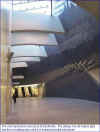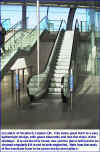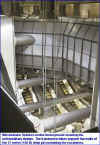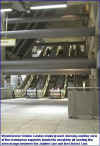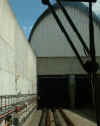This website has been archived from TrainWeb.org/tubeprune to TrainWeb.US/tubeprune.
|
Jubilee Line Extension - PhotosA look at the Jubilee Line Extension, which was opened throughout to connect with the original line on 20th December 1999. ContentsIntroduction - Platform Screen Doors - Canary Wharf - Southwark - Stratford - Waterloo - Westminster - Canning Town Tunnel Entrance IntroductionThe completed extension of the Jubilee Line was opened for passengers on 20th December 1999. The whole project cost £3.2 billion or US$ 5.1 billion. That's £291 million a mile for 11 miles. It was opened two years late and it did not meet all its technical requirements, since it was intended to include a transmission based signalling system capable of running 36 trains per hour. As opened, the line has traditional LU signalling with trainstops, able to support only a 24 tph service. In any case, the line has some fine examples of modern metro station architecture and, if you get the opportunity, you should go and see it. Whether you get to see it or not, here are some photos of the most interesting sites. Platform Screen DoorsA new feature for London Underground is the provision of platform screen doors - sometimes called platform edge doors or PEDs. There was considerable discussion over whether these should be provided, since their true value is in extreme climates where they can reduce station energy costs. In London perhaps their value is more in preventing suicides - London has 100-150 a year - and in showing the public that they have a modern railway. Certainly, at over £1 million a platform face, they don't come cheap. On the Jubilee Line, they are interlocked with the train door operation so that they cannot open unless the train is berthed within a +/- 250 mm margin. It takes 3 seconds to align and open the doors. Here is an example of what they look like.
Click to enlarge. To the Top of this Page Canary WharfCanary Wharf (when it was part of the London docks, it was called Cannery Wharf) station has been built in a huge cut and cover cavern with entrances at the east and west ends. The dug dimensions were 280 m (918 ft) long, 35 m (115 ft) wide and 26 m (85 ft) deep. There is a concourse level, where the ticket offices and faregates are located and a platform level below. Each level is linked by escalators. The following pictures show the principal features. Click on the image for a full size view.
Click to enlarge and see description.
Click to enlarge and see description.
Click to enlarge and see description.
Click to enlarge.
To the Top of this Page SouthwarkThis station is so close to Waterloo, one might ask why it was built at all but it is an interesting station architecturally as the following pictures show. Click on the image for a full size view. Click to enlarge and see description.
Click to enlarge and see description.
Click to enlarge and see description.
To the Top of this Page StratfordThis is another complex station but it is all at surface level. Two separate main line stations are built at different levels while the new Jubilee Line station has been built adjacent to one at the same level. Here are some views of the Jubilee Line area.
Click to enlarge and see description.
Click to enlarge and see description.
Click to enlarge and see description.
To the Top of this Page WaterlooThe station here has had to be incorporated into the existing complex with the main line station, the Eurostar station, the Bakerloo and Northern lines and the Waterloo and City line. A special moving walkway has been provided to reduce the transfer time between the Jubilee Line and other links.
Click to enlarge and see description.
Click to enlarge and see description.
Click to enlarge and see description.
To the Top of this Page WestminsterWestminster station did not open until 23rd December 1999. Its construction had caused some difficulties because it was close to Big Ben and the Houses of Parliament on side side and close to the River Thames on another side. The platforms are on different levels, with the District Line just below street level, then the Jubilee Line eastbound tunnel and, below that, the Jubilee Line westbound tunnel. A large 37 m (120 ft) deep cavern was built for the escalators connecting these different levels. Special, circular transverse support tubes have been installed and they have been incorporated into the design. Click on the image for a full size view.
Click to enlarge and see description.
Click to enlarge and see description.
Click to enlarge and see description.
To the Top of this Page Canning Town Tunnel Entrance
Click to enlarge.
Click to enlarge.
The approach to the tunnel mouth at Canning Town (Fig. 19) as photographed from the front of a westbound train by "Jubilee Pat". Once you go in here, there is tunnel all the way to Finchley Road. Note how the tunnel entrance is made to look like it is part of the Thames Barrier. This appears as if it is part of the London flood defences because the entrance to the tunnel incorporates flood gates. You can make out the horizontal line just under the mouth of the tunnel (Fig. 20) which has the floodgate machinery. If you look at the close-up on the left hand side of the track in Fig. 20 you can see the red light which flashes if the gates are about to be lowered. While not incorporating a signal it is numbered RFL8. I think this arrangement is unique.
|
To the Top of this Page or to the Home Page This page upgraded 21 April 2003 Copyright © Tubeprune 2001, 2002. If you have comments or if you would like to use any part of this site for publishing or commercial reasons, please e-mail me |

















